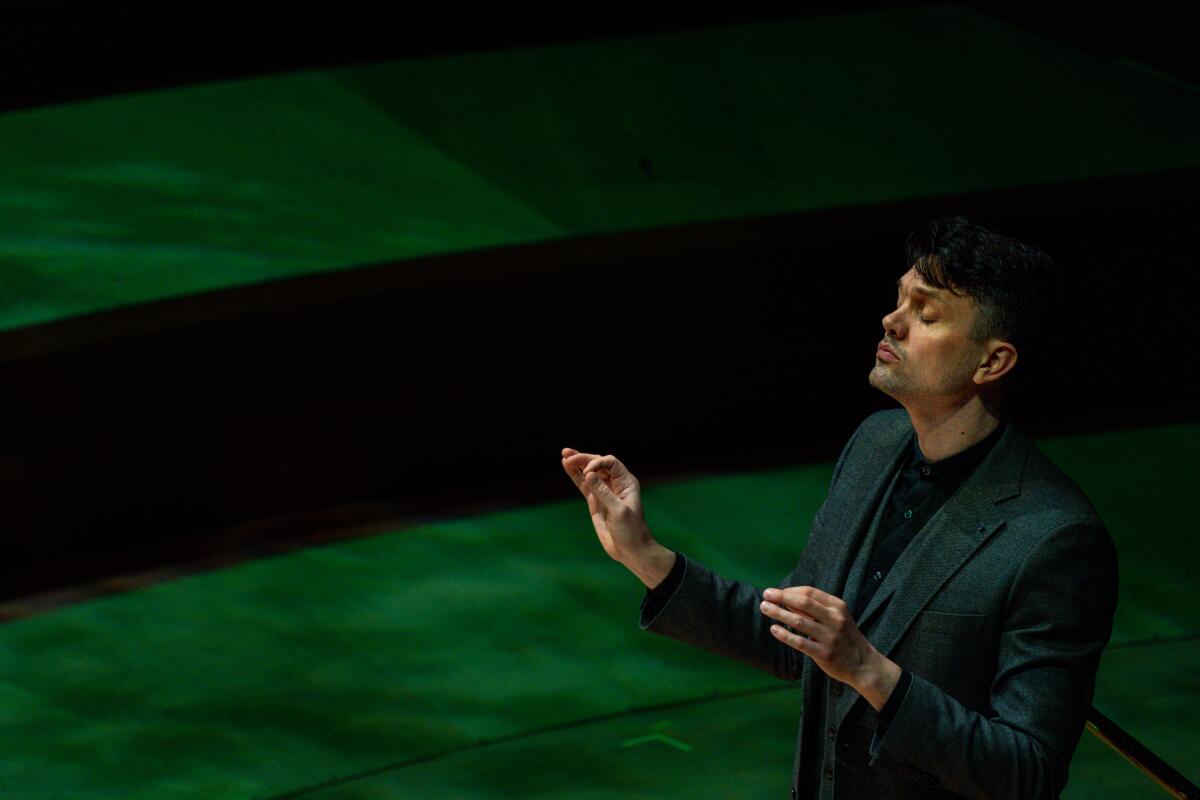Reykjavik stars Daníel Bjarnason and Víkingur Ólafsson shine under the Green Umbrella

- Share via
There may be nothing puzzling about an influx of artists from the Nordic countries to sunny Southern California, but our interest in the chilly north is less expected. Nordic noir is, of course, cool. Do I have to mention Björk? Here’s hoping that evocative Icelandic composer and cellist Hildur Gudnadottir, who is on a roll with Golden Globe and BAFTA awards for her soundtrack to “Joker,” becomes the first woman since 1997 to win an Oscar on Sunday for original score.
The Los Angeles Philharmonic’s quarter-century association with Esa-Pekka Salonen is the primary cause for its Finnish fetish, although it is worth noting that back in the 1920s, the orchestra’s second music director, Georg Schnéevoigt, happened to be a Finn. A Reykjavík festival three years ago proved hip even by L.A. Phil standards.
Last fall, the orchestra turned to Iceland’s leading composer, Daníel Bjarnason, to write something resplendent for Salonen, Gustavo Dudamel and Zubin Mehta to jointly conduct as a celebration of the institution’s 100th birthday.
But butterflies? What’s that got to do with the price of tea in Reykjavik? Not just the “butterfly effect” of some small disturbance far away producing a strong local effect but multicolored wings in full fluttery flight.
On Tuesday night at Walt Disney Concert Hall, the L.A. Phil this time turned over its Green Umbrella concert to Bjarnason and Icelandic pianist Víkingur Ólafsson as cocurators of a program of Nordic new music. It included the premiere of Thurídur Jónsdóttir’s “The CV of a Butterfly.” This, then, meant a Lepidoptera theme, even though, according to the Iceland Review, only six species of butterfly have been spotted on the island, none endemic; it’s an insect that likes changeable weather no more than an average Angeleno.
Then again, Iceland’s mysterious landscape is musical as well as meteorological, a setting for dreams. Bjarnason and Ólafsson framed the program, performed by the L.A. Phil New Music Group and conducted by Bjarnason, with works by Swedish composer Bent Sorensen, the last one being the U.S. premiere of his “Mignon–Papillons,” an extraordinary 25-minute piano concerto. Finnish composer Kaija Saariaho’s “Sept Papillons” was also on the bill.
Although Sorenson’s “The Weeping White Room” and Bjarnason’s “Five Possibilities” were butterfly-free, all in all, it was a night of effervescent trembling, quivering, flickering pulsations, which a post-concert percussion performance further amplified.
Jónsdóttir’s “CV” felt as brief as a butterfly’s life. She is a composer with an ear for evoking landscape and clearly one who had long been waiting for a butterfly to enter. Among her works are “Flutter,” a flute concerto that includes insect sounds, and “Red Ring” for chorus. “CV,” which is for a 16-member chamber ensemble, has a field recording of monarch butterflies. Instrumental colors brush by. The butterfly is a blur. It’s there and, in a quick 10 minutes, it’s gone, and you begin to wonder whether it’s real.
Saariaho’s “Papillons,” performed with ethereal wonder by Calder Quartet cellist Eric Byers (a last-minute replacement for István Várdai, who had a family emergency), is the butterfly in flight heard through the tapping and scraping and subtle pressure of the bow on strings.
Sorensen’s “Mignon” is a different insect altogether. It is the last of a triptych of concerti that all have the same piano part but different accompaniments and different orderings of movements. In this case, there is a small string orchestra, two string quartets lined up behind the main ensemble and violinists Bing Wang and Jin-Shan Dai as soloists standing in the back.
This is butterfly as sensibility, as color and fantasy just out of grasp. The piano writing, butterfly glittery and gorgeous, pulls toward sentimentality. Buttery strings, gorgeous but muted, are like a fog that softens but also distorts. Nothing is solid. Nothing, yet again, is real.
As he had in his stunning Bach recital at Disney last season (and on his bestselling Bach recording), Ólafsson made every note he touched glow. Bjarnason is an eloquent conductor with a bent, you might say, for Sorensen’s sensitivity. It would be hard to imagine a performance as lovely of a 6-year-old piece that seems destined for far wider exposure.
Sorenson’s short chamber orchestra “Weeping White Room” doesn’t make quite as much of an effect, but stark loveliness just out of reach is its character as well. Bjarnason’s own “Five Possibilities” are five very short possibilities for a trio played by Ólafsson, Byers and clarinetist Boris Allakhverdyan, each a burst of instrumental sunlight, in which a butterfly could easily appear.
The L.A. Phil does nothing by half-measure anymore. The postconcert percussion extravaganza, led by the orchestra’s principal timpanist, Joseph Pereira, filled the stage with drums, bells, gongs, mallet instruments galore.
When it comes to the sound of Nordic percussion, the northern lights may be a better metaphor than butterflies. But there was also plenty of fluttering, tapping, tolling, whispering of metal, skin in Bjarnason’s “Qui Tollis,” Saariaho’s “Trois Rivieres” and Rolf Wallin’s “Stonewave.” If monarchs, they were now swarms.
More to Read
The biggest entertainment stories
Get our big stories about Hollywood, film, television, music, arts, culture and more right in your inbox as soon as they publish.
You may occasionally receive promotional content from the Los Angeles Times.











